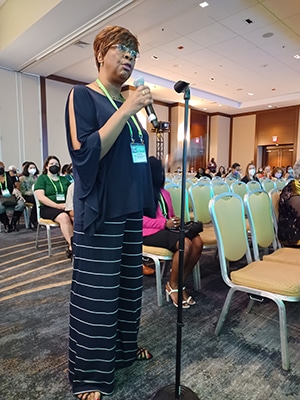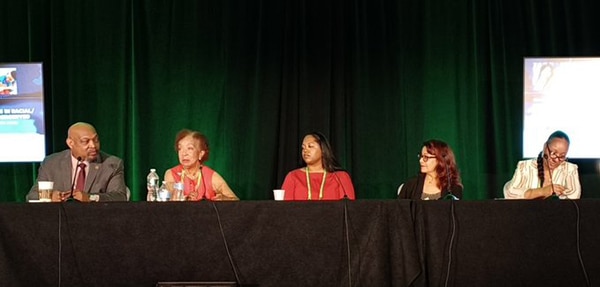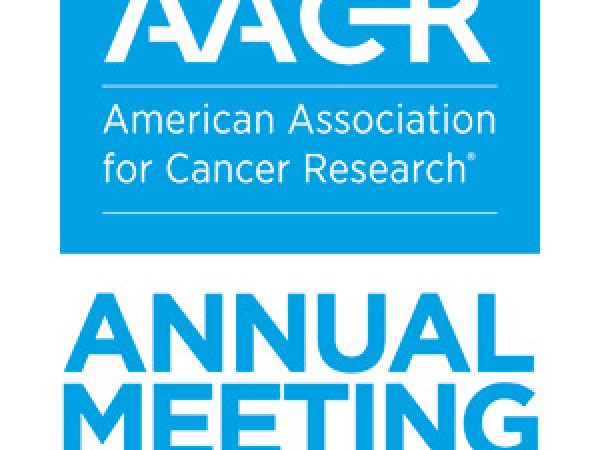Turning Cancer Disparities Research Into Action
In 2008, Robin Evans received a devastating diagnosis: stage 4 metastatic triple-negative breast cancer. This subtype of breast cancer, which disproportionately affects Black women like her, is difficult to treat because it does not express the three most common proteins that can be targeted by approved drugs.
Evans underwent surgery, chemotherapy, and radiation at the Jefferson Health Sidney Kimmel Cancer Center in Philadelphia. One of her oncologists was Edith P. Mitchell, MD, a professor and associate director of Diversity Services at the center. As Evans’s disease stabilized, Mitchell suggested that she start getting involved with patient advocacy.
Evans initially hesitated. After all, she wasn’t a scientist.
“Dr. Mitchell said, ‘I don’t need you for your science. I need you for your voice,’” Evans told the audience at a session at the 15th AACR Conference on The Science of Cancer Health Disparities in Racial/Ethnic Minorities and the Medically Underserved, held by the American Association for Cancer Research (AACR).

Today, Evans is a cancer research advocate for ECOG-ACRIN Research Group and a mentor to newly diagnosed breast cancer patients. She collaborates with multiple organizations to raise breast cancer awareness and share information about clinical trials. She attended this year’s Disparities conference as an advocate, and rose to the microphone to share her experience with the expert panel in a session titled “Closing Persistent Gaps in Cancer Care: Reducing Disparities and Democratizing Cancer Care—A Call to Action.” The session was organized by the AACR Science Policy and Government Affairs office.
This panel was convened with the understanding that disparities research has resulted in some progress, said session chair John D. Carpten, PhD, FAACR, director of the Institute for Translational Genomics at the Keck School of Medicine at the University of Southern California.
“For many years, the AACR has prioritized the need to address persistent racial gaps in cancer care. We’ve published two reports on cancer health disparities, and established priorities such as increasing minority participation in clinical trials; increasing the use of genomic data in underrepresented populations; and increasing minority representation in the cancer research work force,” he said.
“All of these things are moving forward. Now, what are some actionable ways we can continue to close the gap?” Carpten asked.
The panelists had a treasure trove of ideas. Here are eight top priorities.
1. Get more minorities into clinical trials. This overarching goal was addressed in multiple sessions at the Disparities conference. The need is critical: The FDA 2018 Drug Trials Snapshots Summary Report showed that 68 percent of patients enrolled in clinical trials of cancer drugs were white; 15 percent were Asian; 4 percent were Black; and 4 percent were Hispanic. The low enrollment of minority populations in trials is a stark contrast to incidence and mortality rates, which are higher for many minority groups across numerous cancer types.
Three-time cancer survivor Wenora Johnson, MPA, who delivered a meeting keynote address as well as joining the panel, said, “I know I have the possibility of additional cancers in my lifetime. Diversity in clinical trials will provide me with alternative treatment options that will give me an improved quality of life,” she said.
2. Regain momentum in cancer screening. The medical community is scrambling to catch up from the nearly 10 million screenings that were missed during the earliest months of the COVID-19 pandemic. Mitchell pointed out that many of the cancers that can be detected through regular screening—breast, lung, cervical, and colorectal—take a disproportionate toll on people of color. “We know that screening has measurable benefits,” she said. “We need innovative strategies to get screening rates back up and to ensure equitable access.”
3. Help patients navigate the process. Clinical trials generally require regular visits to major cancer centers. The frequency and expense of travel can dissuade some patients from participating, especially patients of lower socioeconomic standing. Bianca Islam, MD, PhD, MSc, a gastroenterology fellow at University Hospitals Cleveland Medical Center suggested implementing some of the lessons that resulted from the COVID-19 pandemic—for example, handling some visits via telehealth so that a patient doesn’t have to miss work. Also, modest, direct financial support could help many patients. “Maybe you do a precall and see what barriers your patient is facing,” she suggested. “Maybe your institution pays for them to park, or to take an Uber.”

4. Share information in diverse ways. Islam applauded programs that share cancer information in familiar neighborhood settings, such as barbershops, nail salons, and churches. Mitchell said one of her former patients holds regular games of bridge at her home, but won’t let the games start until she has talked to her friends about cancer screening. The panelists said conversations among friends are an important way to end the idea that cancer is a taboo subject.
5. Ask patients what matters most. In 2013, Kristi Graves, PhD, of Georgetown University launched a study funded by the Patient-Centered Outcomes Research Institute on the quality of life for Latina breast cancer survivors and their caregivers. Patient advocate Ivis Febus-Sampayo provided extensive feedback on many aspects of Graves’s work, ultimately becoming a co-investigator in the study. She said advocates can provide crucial perspective on whether programs aimed at ending disparities will truly benefit a given community. “You don’t want to keep spending money on interventions that won’t work,” she said. “Patient advocates have knowledge. You have knowledge. Let’s marry them together and make this work.”
6. Pay the people on the front lines. Islam pointed out that many community programs aimed at ending disparities take place on evenings or weekends and are led by professionals who have already put in long weeks of work. In order to make sure community work is valued, it should be paid—not always seen as a volunteer duty. Febus-Sampayo added that paying to send community workers to conferences or classes could empower them and keep them motivated.
6. Make sure the patients stay informed. Johnson said that once patients enroll in clinical trials, they should be kept abreast of any progress or problems. “Share research information with the community before, during, and after the trial,” she urged. Clear communication helps build trust—a well-known concern for many members of minority groups.
7. Reconsider the idea of “community.” Much of the research disseminated at major conferences like the Disparities meeting comes from large academic institutions. Carpten said he’d spoken to an attendee who felt his experience in a small hospital isn’t often reflected in research. “So, maybe we need to redefine what we consider as our ‘communities,’” Carpten said. “We can’t leave those voices out of the conversation.”
8. Celebrate the wins. “I didn’t know anything about cancer research until I got cancer,” Evans told the panel. Now that she is immersed in advocacy, she still sometimes feels that she doesn’t hear enough about the progress that’s been made. “I rarely hear good news, and I really think we have to celebrate the wins,” she said.



